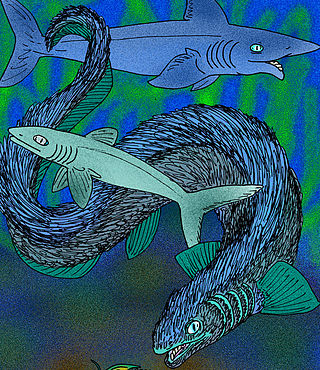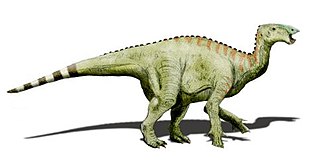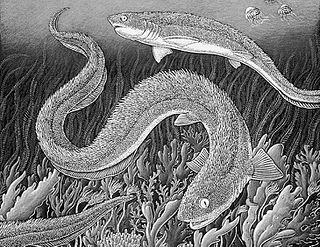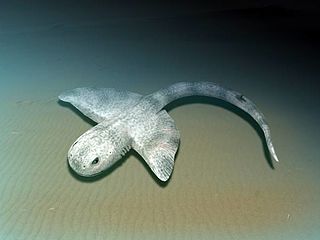The Carboniferous is a geologic period and system of the Paleozoic that spans 60 million years from the end of the Devonian Period 358.9 million years ago (Mya), to the beginning of the Permian Period, 298.9 million years ago. The name Carboniferous means "coal-bearing", from the Latin carbō ("coal") and ferō, and refers to the many coal beds formed globally during that time.

Orthacanthus is an extinct genus of fresh-water xenacanthid sharks, named by Louis Agassiz in 1836, ranging from the Upper Carboniferous until the Lower Permian. Orthacanthus had a nektobenthic life habitat, with a carnivorous diet. Multiple sources have also discovered evidence of cannibalism in the diet of Orthacanthus and of "filial cannibalism" where adult Orthacanthus preyed upon juvenile Orthacanthus. The genus Orthacanthus has been synonymized with Dittodus, Didymodus, and Diplodus.
The Yoredale Series, in geology, is a now obsolete term for a local phase of the Carboniferous rocks of the north of England, ranging in age from the Asbian Substage to the Yeadonian Substage. The term Yoredale Group is nowadays applied to the same broad suite of rocks. The name was introduced by J. Phillips on account of the typical development of the phase in Yoredale, Yorkshire.

Stethacanthus is an extinct genus of shark-like holocephalians which lived from the Late Devonian to Late Carboniferous epoch, dying out around 298.9 million years ago. Fossils have been found in Asia, Europe and North America.

Acanthodes is an extinct genus of acanthodian fish. Species have been found in Europe, North America, and Asia, spanning the Early Carboniferous to the Early Permian, making it one of the youngest known acanthodian genera.

Listracanthus is a genus of extinct chondrichthyan with uncertain affinities. Species of Listracanthus are known primarily from their tremendous, feather-like denticles, which range up to four inches in length. The denticles had a large main spine, from which secondary spines emanate from the sides, like the barbs of a feather or a comb. Listracanthus first appeared in late Carboniferous strata in North America, and eventually disappear from the fossil record some time during the Early Triassic.

Falcatus is an extinct genus of falcatid chondrichthyan which lived during the early Carboniferous Period in Bear Gulch bay in what is now Montana.

Stethacanthidae is an extinct family of prehistoric holocephalians. It is estimated to have existed approximately between 380 and 300 million years ago. Members of this family are noted for their peculiar dorsal fin.
The Taynton Limestone is a geological formation in Oxfordshire in the United Kingdom. It dates to the Middle Jurassic, mid-Bathonian stage. It predominantly consists of ooidal grainstone. The term "Stonesfield Slate" refers to slaty limestone horizons within the formation that during the 18th and 19th centuries were extensively quarried for use in roof tiling within the vicinity of Stonesfield, Oxfordshire. Previously these were thought to belong to the Sharp's Hill Formation, but boreholes and shaft sections suggest that at least three horizons within the Taynton Limestone were quarried for the slate. These horizons are well known for producing a diverse set of fossils including those of plants, insects as well as vertebrates, including some of the earliest known mammals, pterosaurs as well as those of first dinosaur ever described, Megalosaurus.

Ossinodus is an extinct genus of stem tetrapod. Fossils have been found from the Ducabrook Formation in Queensland, Australia dating back to the middle Visean stage of the Early Carboniferous (Mississippian). It was originally placed within the family Whatcheeriidae, but the absence of an intertemporal bone as suggested by a recent reconstruction of the skull based on fragmentary material may prove it to be stemward of all whatcheeriids.

The Whitby Mudstone is a Toarcian geological formation in Yorkshire and Worcestershire, England. The formation, part of the Lias Group, is present in the Cleveland and Worcester Basins and the East Midlands Shelf.

Hypselospinus is a genus of iguanodontian dinosaur which was first described as a species of Iguanodon by Richard Lydekker in 1889, the specific name honouring William Henry Fitton.

Barilium is a genus of iguanodontian dinosaur which was first described as a species of Iguanodon by Richard Lydekker in 1888, the specific epithet honouring the discoverer Charles Dawson.
Kyrinion is an extinct genus of baphetid tetrapod from the Late Carboniferous of England. It is known from a skull that was found in Tyne and Wear county dating back to the Westphalian stage. Along with the skull is part of the lower jaw, an arch of the atlas bone and a rib possibly belonging to a cervical (neck) vertebra. The type species K. martilli was named from this material in 2003.

Cummingella is a genus of proetid trilobite in the family Phillipsiidae that lived from the earliest Carboniferous until the last species' extinction in the Middle Permian. Fossils have been found in corresponding marine strata of Western Europe, the United Kingdom and the United States.
Acondylacanthus is an extinct genus of Euselachian shark from the Paleozoic era. The type species is A.gracilis. Most species are known from the Carboniferous of America and the British isles. A. jaekeli is known from the upper Frasnian of Germany and the Upper Famennian of Russia. This genus is based entirely upon isolated dorsal fin spines, and thus may later be found synonymous with tooth-based genera. Many species have been ascribed to this genus, though there has been some confusion with Ctenachanthus. This genus is in need of review and research.

Listracanthidae is a proposed family of extinct cartilaginous fish. It currently includes the genera Listracanthus and Acanthorhachis. This clade is likely included within Elasmobranchii, but its placement within it is uncertain. Both genera are known from their distinctive spiny dermal dentictles which coat the exterior of their long, slender bodies. They are known from the Viséan to the Early Triassic, mainly from what is now the northern hemisphere. However, there is a possible occurrence in Australia.
Antliodus is an extinct genus of petalodont shark from the Carboniferous Period. It is known from the Mississippian of the United States, Britain, and Belgium Though many species have been reported in the past, a lack of recent revisions means some may be dubious.
Eobaphetes is an extinct genus of embolomere which likely lived in the Pennsylvanian of Kansas. The genus is based on several skull and jaw fragments of a single individual. They were originally described under the species Erpetosuchus kansasensis, but this was later changed to Eobaphetes kansasensis when it was determined that Erpetosuchus was preoccupied by a Triassic reptile.

Squatinactis is a genus of extinct elasmobranch Chondrichthyes known from the Carboniferous aged Bear gulch limestone in Montana. This fish was discovered in 1974 by Richard Lund. The type specimen, named CMNH 46133, consists of a brain case, poorly preserved jaws and gills, a pectoral fin, and a partial vertebral axis. This creatures most startling feature were its broad pectoral fins which resembled those of Stingrays and Angel sharks (Squatina). The holotype specimen has about 15 teeth in its jaw. This creature is named after the angel shark. Teeth found in Derbyshire, England have been tentatively identified as those belonging to S. caudispinatus.













